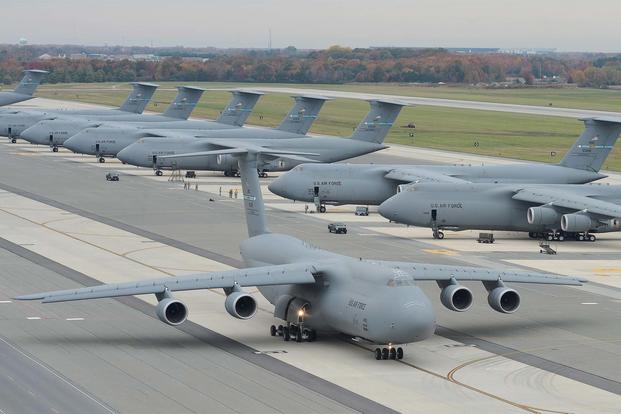The U.S. Air Force has stopped all C-5M Super Galaxy operations from Dover Air Force Base in Delaware after two aircraft experienced nose-gear malfunctions overseas, the service said Tuesday.
Col. Chris Karns, a spokesman for Air Mobility Command, told Military.com that two C-5Ms -- first fielded in 2009 -- have not been able to move the nose-gear "to the fullest extent."
In an emailed statement, the head of the command, Gen. Carlton Everhart, said, "Aircrew safety is always my top priority and is taken very seriously. We are taking the appropriate measures to properly diagnose the issue and implement a solution."
Separate incidents involving C-5M aircraft from Dover occurred May 22 and again Saturday at Naval Station Rota in Spain, in which "the nose landing gear could not extend all the way" on the Lockheed Martin Corp.-made aircraft, Karns said.
Related content:
- General Warns of Need to Boost Airlift Capacity
- Air Force Wants More C-5s on the Flightline
- Military.com Equipment Guide: C-5
The stand-down affects a total of 18 C-5M aircraft from Dover, including 12 primary aircraft and six in backup status, Karns said. If any of the planes were deployed or en route to an interim location, pilots and crew were instructed to hold in place, he said.
Overall, the Air Force as of Sept. 30 had a total of 38 Super Galaxies in the fleet, including 35 in the active force and three in the Reserve component, according to information compiled by the Air Force Association.
The latest setback "will require AMC to work with the 18th Air Force to see where we can make adjustments," Karns said. The numbered Air Force is responsible for tasking and executing all air mobility missions.
The Air Force has said the C-5, the U.S. military's largest transport aircraft, is a crucial capability needed to conduct global operations.
The C-5s have recently been active in Operation Atlantic Resolve -- the Pentagon's missions in Europe designed to reassure allies in response to Russian military activity in the region -- as well as missions into Afghanistan, Karns said.
Everhart said a C-5M earlier this year flew from Travis Air Force Base, California, to Yokota, Japan -- a feat for the 247-foot-long airlifter, which can take off at a maximum weight of 840,000 pounds. Normally, the aircraft stops in Hawaii. But it kept going.
"It's the only airlifter in the inventory that can make the flight non-stop, which means we can put the American flag on the ground in hours versus days," Everhart said.
Budget caps in recent years forced officials to move airlifters into what the service calls backup inventory, "which means we still have the aircraft but lost all manning and funding to operate them," Everhart has said.
In May, officials said that over the next few years, the Air Force plans to allocate funding to move at least eight of the strategic airlifters out of backup status.
"We're going to buy back two a year for four years, if we're able to have a predictable budget to get the fleet back to a higher quality," said Lt. Gen. Jerry D. Harris, the service's deputy chief of staff for strategic plans and requirements.
Everhart has said he wants to activate the C-5s over an even shorter period of time.
"Those eight C-5Ms? I was going to buy them back within a two-year period," Everhart told reporters and lawmakers at a March 31 event at Joint Base Andrews, Maryland. But due to spending caps and the lack of an appropriations bill, he said, that effort has "been delayed twice ... in two budget cycles."
-- Oriana Pawlyk can be reached at oriana.pawlyk@military.com. Follow her on Twitter at @Oriana0214.



























